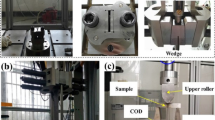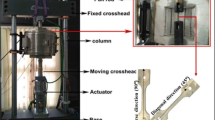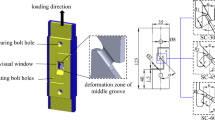Abstract
As the strength grade increases, the cold formability of high-strength steels (HSS) inevitably decreases and the brittleness tendency is obvious. However, in most existing studies on HSS forming the assumption of ductile material was commonly used, and the brittle properties of HSS were not clearly understood. In this paper, a deliberately designed uniaxial twice tensile test was employed to examine the quasi-brittle deformation and fracture behaviors of NM450TP wear-resistant steel plates. FEM models considering non-uniform mechanical properties were constructed, and DC04 plates characterized by typical ductile material were tested for comparison. The results showed that the brittle trend of NM450TP plates causes obvious localized strain during stretching, and the fracture is sensitive to the random initial imperfections. The deformation outside the necking zone is small and the deformation capacity is preserved; thus, it would be conservative to evaluate the formability of HSS by the conventional concept of percentage elongation. The non-uniform FEM models can reproduce the fracture mode of NM450TP plates during tensile tests. In comparison, the ductile DC04 specimens can “average” the mechanical properties before fracture within a wide range via large plastic deformation, and then the deformation is more uniform. The correction index n for conversion of elongation value of NM450TP plates in the Oliver formula was obtained. In the studied cases, n ranges from 0.685 to 0.752 for specimens with gauge length of 150 mm, while it ranges from 0.839 to 0.931 when the gauge length is 15 mm.











Similar content being viewed by others
Data Availability
The authors confirm that the data supporting the findings of this study are available within the article.
Code Availability
Not applicable.
References
K. Mori, P.F. Bariani, B.A. Behrens, A. Brosius, S. Bruschi, T. Maeno, M. Merklein, and J. Yanagimoto, Hot Stamping of Ultra-High Strength Steel Parts, CIRP Ann. Manuf. Technol., 2017, 66, p 755–777.
D.Y. Shi, K. Watanabe, J. Naito, K. Funada, and K. Yasui, Design Optimization and Application of Hot-Stamped B Pillar with Local Patchwork Blanks, Thin Wall Struct., 2022, 170, p 108523.
Y. Jang, Y. Lee, M. Song, D. Han, N. Kim, and H. Lee, Evaluation of Ductile Fracture in Welded Tubes with Tensile, Hardness, Flaring Tests, Int. J. Mech. Sci., 2021, 210, p 106745.
D. Staupendahl, and A.E. Tekkaya, Mechanics of the Reciprocal Effects of Bending and Torsion During 3D Bending of Profiles, J. Mater. Process. Tech., 2018, 262, p 650–659.
A.M. Arola, A. Kaijalainen, V. Kesti, L. Troive, J. Larkiola, and D. Porter, The Effect of Mechanical Behavior on Bendability of Ultrahigh-Strength Steel, Mater. Today Commun., 2021, 26, p 101943.
P. Sartkulvanich, B. Kroenauer, R. Golle, A. Konieczny, and T. Altan, Finite Element Analysis of the Effect of Blanked Edge Quality Upon Stretch Flanging of AHSS, CIRP Ann. Manuf. Technol., 2010, 59, p 279–282.
J. Lian, J. Wu, and S. Munstermann, Evaluation of the Cold Formability of High-Strength Low-Alloy Steel Plates with the Modified Bai-Wierzbicki Model, Int. J. Damage Mech., 2015, 24, p 383–417.
X.W. Huang, J.Z. Ge, J. Zhao, and W. Zhao, A Continuous Damage Model of Q690D Steel Considering the Influence of Lode Parameter and its Application, Constr. Build. Mater., 2020, 262, p 120067.
H. Tang, T. Wen, Y. Zhou, J. You, and D. Ma, Study on the Wrinkling Behavior of Perforated Metallic Plates Using Uniaxial Tensile Tests, Thin Wall Struct., 2021, 167, p 108132.
A. Kocańda and C. Jasiński, Extended Evaluation of Erichsen Cupping Test Results by Means of Laser Speckle, Arch. Civ. Mech. Eng., 2016, 16, p 211–216.
L. Zhang, J. Lin, J. Min, Y. Ye, and L. Kang, Formability Evaluation of Sheet Metals Based on Global Strain Distribution, J. Mater. Eng. Perform., 2016, 25, p 2296–2306.
L. Ding, J. Lin, J. Min, Z. Pang, and Y. Ye, Necking of Q&P Steel During Uniaxial Tensile Test with the Aid of DIC Technique, Chin. J. Mech. Eng., 2013, 26, p 448–453.
V. Prakash, D.R. Kumar, A. Horn, H. Hagenah, and M. Merklein, Modeling Material Behavior of AA5083 Aluminum Alloy Sheet Using Biaxial Tensile Tests and its Application in Numerical Simulation of Deep Drawing, Int. J. Adv. Manuf. Technol., 2020, 106, p 1133–1148.
D. Gross and T. Seelig, Fracture mechanics (second edition)-Mechanical engineering series, Springer, Berlin, 2011.
F. Hejazi, H. Karim, H. Kazemi, S. Shahbazpanahi, and A. Mosavi, Fracture Mechanics Modeling of Reinforced Concrete Joints Strengthened by CFRP Sheets, Case Stud. Constr. Mater., 2022, 17, p e01273.
M. Zhou, Y. Li, Q. Hu, X. Li, and J. Chen, Investigations on Edge Quality and its Effect on Tensile Property and Fracture Patterns of QP980, J. Manuf. Process., 2019, 37, p 509–518.
Y.S. Lou, H. Huh, S. Lim, and K. Pack, New Ductile Fracture Criterion for Prediction of Fracture Forming Limit Diagrams of Sheet Metals, Int. J. Solids Struct., 2012, 49, p 3605–3615.
Y. Liu, D. Fan, S.P. Bhat, and A. Srivastava, Ductile Fracture of Dual-phase Steel Sheets under Bending, Int. J. Plast., 2020, 125, p 80–96.
W. Zhou, Y. Sun, Q. Wang, and L. Ding, Effect of Quenching and Partitioning Process to Low-Alloy Wear Resistant Steel, J. Mater. Res., 2016, 31, p 663–669.
N.N. Sergeev, A.N. Sergeev, S.N. Kutepov, A.E. Gvozdev, A.G. Kolmakov, and D.S. Klementev, Influence of Heat Treatment on Residual Stress Formation in the Wear-Resistant Steel 60 – Steel 15 – Steel 60 Bimetal Material, Inorg. Mater., 2021, 12, p 5–9.
X.H. Hu, X. Sun, L.G. Hector Jr., and Y. Ren, Individual Phase Constitutive Properties of a TRIP-Assisted QP980 Steel from a Combined Synchrotron X-ray Diffraction and Crystal Plasticity Approach, Acta Mater., 2017, 132, p 230–244.
H. Tang, T. Wen, Y. Zhou, F. Yang, and Y. Zheng, Finite Element Modeling of Tensile Instability of Sheet Metals Considering Nonuniform Mechanical Properties, J. Mater. Eng. Perform., 2022, 31, p 3753–3762.
International Organization for Standardization, Steel conversion of elongation values. Part1 Carbon and low alloy steels, ISO 2566-1-2021
X.D. Chen, Y.Y. Li, X.H. Han, and J.B. Zhang, Size Effect Studies on Tensile Tests for Hot Stamping Steel, J. Mater. Eng. Perform., 2018, 27, p 640–647.
Funding
This work was supported by the Natural Science Foundation of Chongqing, China (cstc2020jcyj-msxmX0420).
Author information
Authors and Affiliations
Corresponding author
Ethics declarations
Conflict of interests
The authors declare no competing interests.
Additional information
Publisher's Note
Springer Nature remains neutral with regard to jurisdictional claims in published maps and institutional affiliations.
Rights and permissions
Springer Nature or its licensor (e.g. a society or other partner) holds exclusive rights to this article under a publishing agreement with the author(s) or other rightsholder(s); author self-archiving of the accepted manuscript version of this article is solely governed by the terms of such publishing agreement and applicable law.
About this article
Cite this article
Li, Gn., Wen, T., Zheng, Y. et al. Quasi-brittle Deformation and Fracture Behaviors of NM450TP High-Strength Wear-Resistant Steel Plates during Twice Tensile Test. J. of Materi Eng and Perform 32, 8870–8879 (2023). https://doi.org/10.1007/s11665-022-07748-7
Received:
Revised:
Accepted:
Published:
Issue Date:
DOI: https://doi.org/10.1007/s11665-022-07748-7




